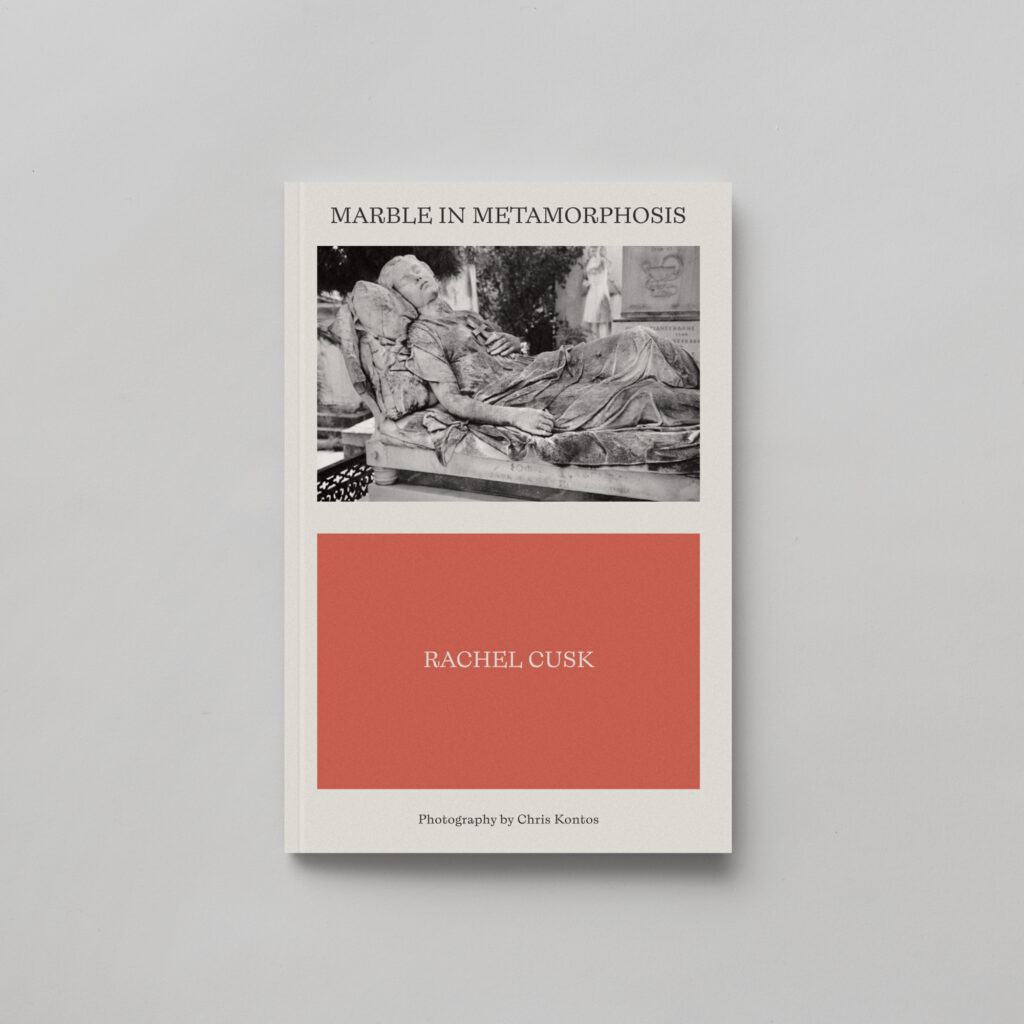The ethos of marble is endurance, and as such it has no particular morality of its own. It represents a concept of change that is difficult to grasp. As a material marble lies outside any given moment: having already changed, and thereby become changeless, it is no longer subject to time. It speaks to us not as individuals but as participants in an ongoing history. It reminds us of the impermanence that underlies these individual possessions of ours, these bodies, these selves, and asks us to ally ourselves with something more collective and enduring. Do we wish to endure? In marble we could inscribe what we wish of ourselves to endure: marble is a material for a pure and almost a monomaniacal intention. The survival of marble, like the survival of certain memories while others vanish, is likewise a kind of subjectivity. A story is made out of what survives. Other ways in which stories are told – the stories of influence and becoming, of unconscious action and belief, moral and oral histories – do not have a location as resilient as that of marble. They can be influenced or modified; they can evolve, or dwindle away. To an extent a story is made out of the juncture between the immaterial and the material. In marble the distance between the two – between fleetingness and survival, between expressiveness and dumbness – is immense. So much of what we do is forgotten or isn’t good enough. So who can be the author of this material?
–
The village ought to be a quiet place, yet every day the air is filled with the noise of building work. The old houses are being refurbished by newcomers, people with vision and money. At the house directly behind ours, a group of men are blasting out an area of hillside to uncover the remains of another building that apparently are buried on its land. We have been told that this is a common ruse among property developers, since it is difficult here to get permission to build something new. The rubble they are digging for is merely the justification of their intentions, which are to put up two new houses that can be sold for profit. Every morning shortly after sunrise they start their pneumatic drill and spend the day breaking up the hard rock underfoot. On the first day, dismayed by the deafening noise, we walked around to the house to talk to its owner, an American with a distinctly unrepentant manner, who told us that the drilling was likely to continue for the whole extent of our stay. He outlined for us the history and progress of these works, which began with the felling of all the trees on the site, followed by a period of exploration, in which the men dug at the hillside with shovels in the hope of striking – as it were – gold. Once they had ascertained that the remains were there, the American had applied for a permit, which had taken some time to come through. Now that he had it, he was not about to desist on our account. Find somewhere else to stay, he said imperiously – it’d be the cleanest thing. Later he offered us lettuces from his vegetable garden, and a bottle of olive oil, and seemed satisfied that he had evened things out. Every lunchtime we eat the prospector’s lettuce, garnished with a few drops of his olive oil, shouting at one another above the noise.
I have often considered the merits of insensitivity, and thought how much better it would be not to be continually pained by the activities of other humans, even at the cost of losing what might be distinctive about oneself. But in fact the building work is a simple exercise in perspective: were I in the American’s shoes, perhaps I would be doing the same thing. Most people live cosseted in the vague belief that their existence and the work that they do are essentially non-destructive, but hardly anyone in our era can really say that about themselves. These days, the very condition of being alive represents an act of extortion: it is unavoidable. The American is merely making his extortion audible and visible. Unlike him, the men who are doing the work are local: I watch them from the garden, unable to understand their talk and so reading instead their mannerisms and gestures, their bearing toward one other and their employer. They seem gentle and respectful. They aren’t responsible for the destruction and the noise, yet these things, and the change that will result from them, are their work.
Two things – beauty and horror – are especially lasting, and in the built environment they frequently come intertwined. The grandiosity of marble, for instance, bequeathed it by classicism and religion, easily becomes the grandiosity of fascism. Looking at images of the Palace of the Parliament in Bucharest – the world’s heaviest building, so heavy that it sinks six millimetres into the earth every year – it is hard not to see in it a tremendous spectacle of wrongful labour. It is a colossus that represents the translation of a dictator’s will into a physical and spatial reality. Other feats of building and engineering – the nearby strait of Corinth, for instance – are triumphs of human will whose fathomless cost in physical toil is impossible to ignore: a kind of uneasiness attends these marvels, which remind us how far progress has relied on the existence of inequality. The Palace of the Parliament seems to ask a different question, which is a question about the moral status of oppression: can a person in a state of oppression be deemed blameless for his or her acts? The building of this pointless edifice entailed the displacement of 40,000 residents of Bucharest and the demolition of an entire quarter of the city that also housed monasteries, libraries and museums. Over a million cubic metres of marble were used in the construction. The men who built it were not labourers or soldiers: they were termed ‘volunteers’, the question of their will thus being conveniently settled. It was a compulsory sort of volunteering, however: in fact they were little more than slaves. The palace is the world’s third-largest building, yet fewer than half of its thousand-plus rooms were ever completed. It is an image of the suddenness with which a dictator’s power can be extinguished.
The artist and the dictator stand at opposite ends of the concept of agreement, which is essentially the concept of storytelling. As a story does, the created object seeks agreement: unless successive generations agree with the statement the object makes, it will be destroyed by time. The artist makes a bet on that future perspective, even at the cost of dispensing with agreement in the now. By contrast, the dictator tries to stop time and control the future, by staking everything on the present moment. Where the artist is often weaker than the things he creates, the dictator struggles to create something that will outlast him. Yet both are bent on commemorating their vision by embodying it in that which exists outside themselves, that which is concrete. The artists and dictators of our time are increasingly interested in immateriality: the new forms of power are digital, the new art an art that doesn’t rely on concretisation. When the artist Michael Landy publicly destroyed everything he owned, including works he possessed by other artists, he was making a statement about the hopeless corruption of the object world, from which art must attempt to separate itself. The British artist Andy Goldsworthy often makes works whose substance is the simple act of perception: uncoupled from representation, they are embodied in the object-value of what is seen, to whose fleetingness the artist surrenders. Goldsworthy’s art could be termed non-egotistical, since its materials belong to and can be recouped by nature: it is an art of minimal interference, of non-competition, one which, theoretically at least, permits anyone to be an artist. It is resistant to dogma and misinterpretation, yet is it also perhaps resistant to responsibility? By creating a lasting object, the artist takes responsibility for those who look at it, now and into the future. He believes he can communicate with those future people, and reassure them that their surmises about the world and its truth are the same as his own.
Michelangelo, famous egotist, regarded marble as the most formidable of all prisons of the human idea. ‘The greatest artist has no conception,’ he is quoted as saying, ‘which a single block of marble does not potentially contain within its mass, but only a hand obedient to the mind can penetrate to this image.’ Liberating the image from its confinement in the material is a supreme act of human domination, is to stamp existence on the most indifferent and immortal of stones. What this domination relies on – like all domination – is obedience, the obedience of the self, the hand, to the mind’s intentions. Michelangelo’s hand is his slave, like the actual slave of the dictator, bent to a will outside itself. For the human idea doesn’t only extend to truth and beauty: if the block of marble contains all ideas, all conceptions, it is equally full of evil.
–
We go to visit a quarry, where for centuries marble has been taken out of the earth. Along the road the villages become more and more marble-clad, as though this nearby opening of the earth had spattered them with its contents. The terrain rises into black vertiginous peaks: the villages cling to the steep hillsides, radiant white, rinsed by violent winds. The traditions and techniques of marble sculpting have been conserved here through successive generations. It is possible, we are told, for even an expert in these matters to fall into conversation with an old man in a local cafe and learn something new. In one of the larger villages there is a school where the art of marble sculpting is formally taught: the students’ works-in-progress stand around the studio.
There is a block of marble there too, as yet untouched. A block of marble has a skin, beneath which its compacted layers become increasingly dense. It is composed of infinitesimal leaves, like a giant fine-paged book, that can easily be damaged. It is unexpectedly vulnerable: the students are taught to approach it with infinite caution. It can take as long as two years for them to shape a form from it, though an expert could do it in a month. The flash, the impulse of art would seem to be reined in – almost extinguished – by these conditions: the artist’s gesture cannot be modified or retracted; their intentions, across this agonisingly slow creative process, cannot be altered. Rarely has the discipline, the un-freedom of art appeared more exacting – and indeed as art has sought over centuries to overcome the tension between discipline and creativity in order to produce change, inevitably the medium of marble has fallen deeper into conservatism. The new masters of marble – such as the students here will become – often find work as restorers, repairing and reassembling the broken forms of the ancient world that are always being raised up again from the earth.
Yet in the modern era certain artists are using marble as a location where a new ambivalence about history and power, about the meaning of the monumental, can be expressed. The Canadian artist Rebecca Belmore’s marble replica of a cheap tent is an anti-monument, forcing the iconographic material into a dialogue with the state of displacement and homelessness. The Greek sculptor Andreas Lolis uses marble to create forms that represent the very concepts of disposability and waste: overstuffed bin bags, broken crates, crushed cardboard boxes. In Lolis’ work, the relationship of time and forgetting to the durability of materials is turned inside out: here the medium is asked, painstakingly, to see that which is antithetical to itself, to notice what is beneath notice and commemorate it. Marble – the signifier of importance – is asked to bend itself to an act of recognition, the recognition of reality. Lolis’ father was a stonemason: his relationship with marble began in childhood, when he slowly taught himself to make the material represent what he saw around him, against the formality of what was thought suitable to be seen. For other artists the technical difficulty of working in marble negates the possibility of using it as a medium. Belmore’s tent, for instance, was carved by a graduate of the school here, in this village. Yet in the publicity surrounding that work, his name is nowhere mentioned. The art of marble carving has an uncertain status, just as it did when Michelangelo regarded his hand as his slave.
The quarry is a couple of miles out of the village, over a hillside facing the sea. The road rises, writhes through spurs of black rock and then plunges downward into the steep and savage landscape on the other side. It coils around the chasm-like mountainside with its dark and uninhabited vistas, the sea plunged far below. The great wound of the quarry appears some way down, along with other, older wounds: these belong to history, to the long account of human effort in plundering and shaping the world. In the nineteenth century the English quarried here, in a gash visible far down at the water’s edge. By an almost maniacal feat of engineering, they even dug out the sea bed to quarry beneath the water. From the quarries higher up, the giant blocks of marble were manually handed down the mountainside, turned laboriously over from end to end.
It is evening, and the working quarry is deserted. Filthy trucks are parked here and there. The floor is a potholed mire of wet clay. The quarry is deep and steep-sided, its towering rectilinear façades at odds with the forms of nature: they look like the sides of buildings, as though the mountain already contained the idea of a city in its innards. Metres of rock and earth have to be blasted away to reach the marble below, and these layers are clearly visible on the exposed faces. The determination of man to reach the idea of a built environment, the idea of marble: even in the machine era, it is a scene of primitive struggle. One of the island’s oldest marble sculptors has known this quarry since he was a boy: his father and grandfather were both quarrymen. In his earliest recollection it was a deep narrow channel cut into the earth. Now it is an arena, a brutal amphitheatre caked in mud and dust, facing the emptiness of sky and sea. As machines have come he has witnessed the diminution of toil here, which is also the ascent of human value. There has been a consequent loss of knowledge, of instinct: the great rough-cut blocks that stand around awaiting transportation elsewhere have to be clearly marked to show which is the right side up, because the quarry workers can no longer tell. The metamorphosis of which marble is the result comes about through pressure: if it is inverted it begins to lose its structural integrity. It is an image, in a way, of civilisation itself, the stress of its formation giving way to an ease which dismantles it, giving way to forgetting.
The story of marble’s purity begins here, in the gradations and characteristics of the hewn-out mountainside. Intact, the façade is a kind of book, full of contrasts and passages of drama and colour, yet unintelligible and unshaped. In the editing process that follows this exposure of the material, the more consistent sections are preferred to the florid, wildly patinated ones. A particularly pale and unmarked face is the focus of current attention: it has been demarcated into slabs in preparation for cutting with long, fine copper cables studded with small diamonds that lie in great coils on the muddy ground. A few faint lines thread their way across the white façade, like tracks across snow. The discovery of this section has been the cause of excitement: it will make slabs of unusual size and quality. In the world of capitalism, white marble isn’t just for monuments and dictators’ palaces – it is a luxury material for the home. Cut to size, carefully polished and prepared, this lofty material, in which humans for centuries have inscribed their exceptionality and the grandeur of their vision, has finally been democratised.
Image © Chris Kontos.

This is an excerpt from Marble in Metamorphosis by Rachel Cusk and Chris Kontos, published by Molonglo.







